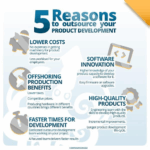In the digital age, a potential product marketing strategy is crucial more than ever, closely aligning with the product development process to ensure seamless execution.
Are you worried about a well executed strategy for ensuring a successful launch of the new product? This comprehensive guide outlining the key steps to develop effective marketing strategies, from market analysis to identifying target audiences with the importance of SWOT analysis and pricing strategies.
Also a detailed discussion over proactive and reactive strategies and its potentialities for the product launch will be discussed to provide a framework for your marketing efforts.
Proactive vs. Reactive Product Marketing Strategies
Before exploring the importance of product marketing strategy, it is vital to have a detailed overview of the difference between proactive and reactive approaches.
Reactive Product Marketing
The reactive product marketing relies on reviews from field teams such as sales, customer success, implementation and support. This strategy focuses on responses to challenges and opportunities as they arrive for market interaction. Numerous experts in product marketing believe that this approach helps in minting real time product adjustments.
Field terms provide important insight based on unique metrics such as sales quotations or customer satisfaction scores.
By addressing these concerns, companies can opt for such strategies that can meet current market demands effectively.
Proactive Product Marketing
On the contrary, proactive marketing includes analyzing product performance through the customer lifecycle to unveil the trends and opportunities. This method completely depends upon dta analysis, evaluation of both qualitative and quantitative information. This marketing strategy for the product allows marketers to judge the possible market shifts and identify key areas for improvement before issues further worsen.
This marketing strategy provides a broader perspective compared to the reactive model, providing data driven results with long term strategic planning for sustainable growth.
A product development company like Brand New MD can assist in implementing both proactive and reactive marketing strategies, ensuring that your product remains competitive in the market.
Analyzing the Market
Conducting Market Research
To develop a Resilient product marketing strategy, that is initiated through market research. This process includes highlighting the target audience and understanding the needs and wants. Market research aids in providing answers to critical questions about customer preferences, current usage, and desired features in the product both primary and secondary research crucial elements for this phase.
Primary Research
In this research the marketing team has direct interactions with current customers through surveys, interviews and focus groups. The insights collected should highlight the detailed buyer or user personas, identifying the desired features and rooms for improvements required by the potential customer.
Secondary Research
In this type of research existing data from external sources such as market databases, industry reports and competitor websites is collected which help assess the commercial viability of your product and refine your pricing modules by comparing with market trends.
Competitive Intelligence
Understanding your competitors’ strategy is as crucial as developing yours. Competitive intelligence is gathering information about your competitors’ offering and market position. This can be attained through external and internal research.
External Research
External research to evaluate your competitors current position is his websites, press release and social media handles. A latest study reveals that more than 70% of product marketers rely on press releases to gather insight for his competitors.
Internal Research:
This involves using in-house communication, such as emails and discussions with sales and executive teams. This strategy helps in gathering relevant stats from within the organization, which can verify the external data.
Categorizing Competitors
Once competitors are identified, divide them in category into primary, secondary, and tertiary competitors:
Primary Competitors
These competitors compete directly with your product and have the same audience to target. For example Nike and Adidas offer athletic shoes to the same customer base.
Secondary Competitors
These competitors offer the same product but target slightly different consumers . for example pepsi and coca-cola sell carbonated beverages but may appeal to different sets of demographics.
Tertiary Competitors
These competitors provide different products to the same audience as yours. For example fitbit and apple both target health-conscious users, while fitbit mainly focus on fitness tracker while apple offers a wide range of tech products.
Conducting a SWOT Analysis
Through SWOT analysis one can evaluate strengths,weaknesses, opportunities and possible threats- which is a critical step to create marketing strategy. This analysis aids in getting familiar with about you current position of your product and identifying areas for growth.
Strengths:
Identify what differentiates your product from the market competitors. This could include diverse features, brand reputation, or an existing market presence.
Weaknesses:
Identify and work on any limitations that could hinder the market success of your product, such as scarcity of resources or marketing shortcomings.
Opportunities
Identifying rooms for growth such as influencing marketing trends can be adopted while adopting new technological advancements or unmet customer demands.
Threats
Evaluate external factors that have negative impacts on your product including economic downfalls and competitive pressures.
Identifying Your Target Market
Understanding the market relies on categorizing the market according to demographics, psychographics, and behavioral patterns. This category’s division aids in specifying customer needs and preferences.
This segmentation helps in setting your marketing efforts to specific customer needs.
- Demographic Segmentation: Includes age, gender, income level, and education.
- Psychographic Segmentation: Focuses on lifestyle, interests, and values.
- Behavioral Segmentation: Analyzes customer behavior, including purchase patterns and brand loyalty.
Pricing Your Product
Setting the ideal price is important for setting your product as the perfect choice of the customers. Your pricing strategy reflects the value of your product aligned with the market demand.
Consider factors such competitor pricing, production cost and customer standard income based on the research that was done prior to the release.
The primary and secondary research helps in determining the optimal price that maintains profit along with market competitiveness.
Conclusion
Crafting an effective product marketing strategy in 2024 involves a comprehensive approach that influences proactive and reactive strategies, market analysis, competitive insights, and a thorough SWOT analysis. By understanding market dynamics, identifying your target audience, and setting a strategic price, you can enhance your product’s market positioning and achieve success.
Remember, the key to a successful product marketing strategy lies in continuous adaptation and responsiveness to market changes and customer needs.
For expert guidance and support, you can rely on Brand New MD, a leading product development company. Whether you’re launching a new product or enhancing an existing one, their team can provide the insights and resources to ensure success. For more information, feel free to contact Brand New MD and learn how they can help take your product to the next level.
If you want to read more interesting articles, you can read the following ones:









